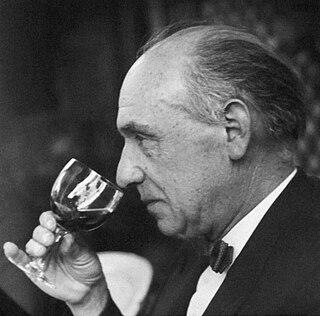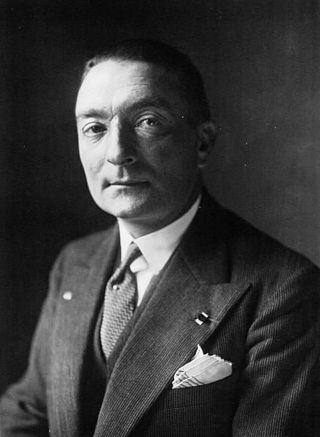Related Research Articles

Pierre Marie Gabriel Vincent Ernest Leroy de Boiseaumarie (1890-1967), nicknamed Baron Le Roy, was a World War I fighter pilot credited with five aerial victories.
Capitaine Paul Louis Malavialle was a French World War I flying ace credited with five aerial victories.
Capitaine Jean Marie Émile Derode was a French World War I flying ace credited with seven aerial victories.

Lieutenant Jean Marie Luc Gilbert Sardier (1897-1976) was a World War I flying ace credited with 15 aerial victories. He remained active in aviation following World War I. During World War II, he was deeply involved in a veterans organization that collaborated with the occupying Nazis.
Sous Lieutenant Marcel Joseph Maurice Nogues was a World War I flying ace credited with thirteen aerial victories. He was an ace over enemy observation balloons, as well as enemy airplanes.
Lieutenant Colonel Marcel Anatole Marie Esprit Hugues was a French flying ace during World War I. He served before, during, and after the war, as he was a professional soldier. Later, he came out of retirement for World War II service and led Groupe de Chasse II/5 in its opening campaign against the invading Germans.
Lieutenant Colonel Charles Marie Joseph Leon Nuville LH was a French World War I flying ace credited with twelve confirmed aerial victories. He served as a professional soldier throughout the interwar years, and through World War II.

The MVSerenade was a French ocean liner and later cruise ship, operating until 2008 when she was sold for scrap.
Lieutenant Jean Seraphin Benjamin Emmanuel Bozon-Verduraz was a French flying ace during World War I. A prewar soldier, he was recalled and switched from cavalry to aviation to achieve 11 confirmed aerial victories.
Général Auguste Joseph Marie Lahoulle was a French military officer who began his career as a World War I flying ace. He was a double ace during the war, credited with ten confirmed aerial victories.
Capitaine Jean Georges Fernand Matton was a French World War I cavalryman and flying ace. He was credited with nine confirmed and two unconfirmed aerial victories.

Escadrille 3Les Cigognes was a famous French aviation unit during the World War I. It was often referred to as the 'Stork Escadrille N3' due to its insignia. Pilots from Groupe de Combat 12 adopted the name and placed images of storks in different phases of flying on their planes.

Escadrille 103 of the French Air Force was an elite aviation unit on the Western Front during World War I. One of its many aces, René Fonck was the highest scoring Allied fighter-pilot.

Escadrille 73 of the French Air Force originated at Corcieux on 23 May 1915 as Detachment N 49 during the World War I.
Escadrille 67 of the French Air Force was founded at Lyon-Bron Airport during the First World War, on 17 September 1915. On 24 September, they were assigned to the IV Armee of the French Army. By late October, the escadrille was assigned to the defense of Verdun.

Escadrille 31 of the French Air Force was founded at the beginning of the World War I, on 24 September 1914, at Dijon Air Base. Once equipped with Morane-Saulnier Ns, it was posted to I Armee of the French Army.
Escadrille 57 of the French Air Force was founded during World War I, on 10 May 1915.

The Fabre Line or Compagnie Française de Navigation à Vapeur Cyprien Fabre & Compagnie was a French shipping line formed in 1881 by Cyprien Fabre. It began operating a small fleet of sailing ships in 1865. Its ports of call included New York, NY; Providence, RI; Boston, MA; Ponta Delgada, Madeira, and Lisbon, Portugal; Piraeus and Salonica, Greece; Algiers, Algeria; Beirut, Lebanon; Naples and Palermo, Italy; Alexandria, Egypt; Jaffa and Haifa, Palestine; Constantinople, Turkey; Monaco; and Marseilles, France.

The Compagnie Fraissinet, a Marseilles-based shipping line, played an important role in trade and immigration flows in the Mediterranean, Black Sea, Western Africa and Latin America. The Compagnie Fraissinet added Northern America to its routes after a merger with the Compagnie Française de Navigation à Vapeur Cyprien Fabre & Cie. The Compagnie Fraissinet operated for close to 150 years through two World Wars, several revolutions, and the colonization and decolonization periods. The Fraissinet family started divesting from shipping activities in the 60s to concentrate on aviation and media. Fraissinet lowered its flag in 1968, the tanker Alfred-Fraissinet being the last ship of the company. Fabre kept on operating until 1979.
Escadrille Spa.78 was a French fighter squadron active from December 1916 until the end of World War I on 11 November 1918. It spent most of its existence as a component of a larger Groupe de Combat involved in offensive operations. The squadron was credited with a minimum of 40 confirmed aerial victories during the war.
References
- Notes
- Citations
- 1 2 3 4 5 6 7 8 Over the Front, p. 162.
- ↑ Society of World War I Aero Historians: Cross & Cockade Journal . Volume 26, Issue 6, page 8.
- 1 2 3 4 5 6 7 8 9 Les Marseillais dans l'histoire: Volume 3 of Les Hommes dans l'histoire. Pierre Guiral, Félix Reynaud. Privat, 1988. ISBN 2-7089-9404-2, ISBN 978-2-7089-9404-1. Via Fraissinet (Shipping company, France) Flags of the World. Retrieved 2011-11-01.
- ↑ Château Saint-Maur: The Landowners. Château Saint-Maur. Retrieved 2011-11-01.
- ↑ Château Saint-Maur: The Farm. Château Saint-Maur. Retrieved 2011-11-01.
- 1 2 Jean Fraissinet. Assemblee Nationale. Retrieved 2011-11-01. Translation via Babelfish.
- Bibliography
- Over the Front: A Complete Record of the Fighter Aces and Units of the United States and French Air Services, 1914-1918 Norman L. R. Franks, Frank W. Bailey. Grub Street, 1992. ISBN 0-948817-54-2, ISBN 978-0-948817-54-0.